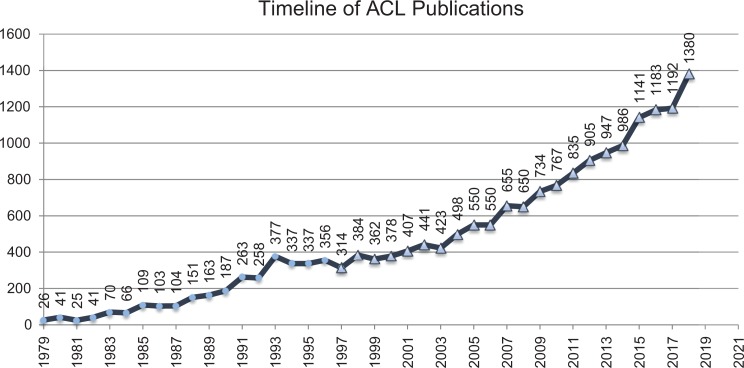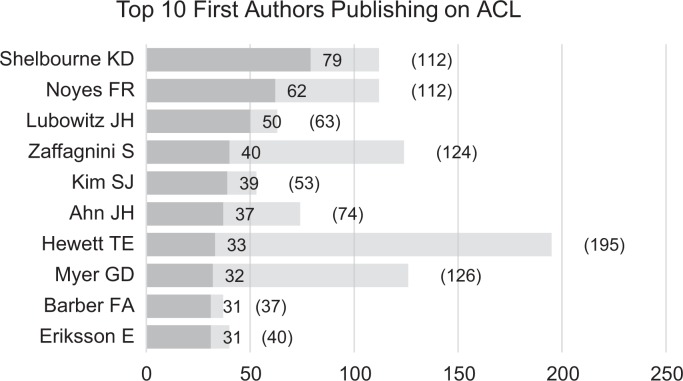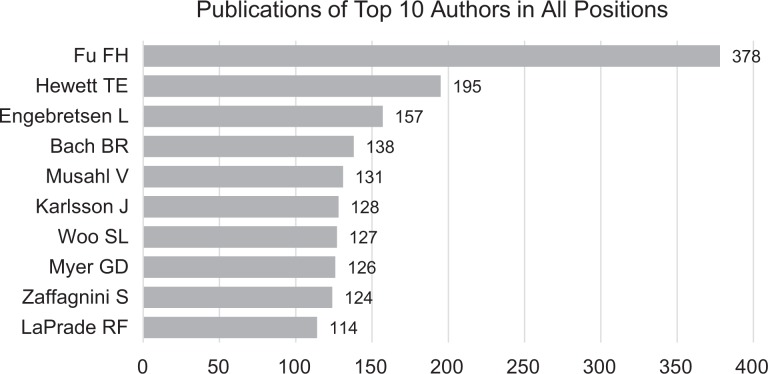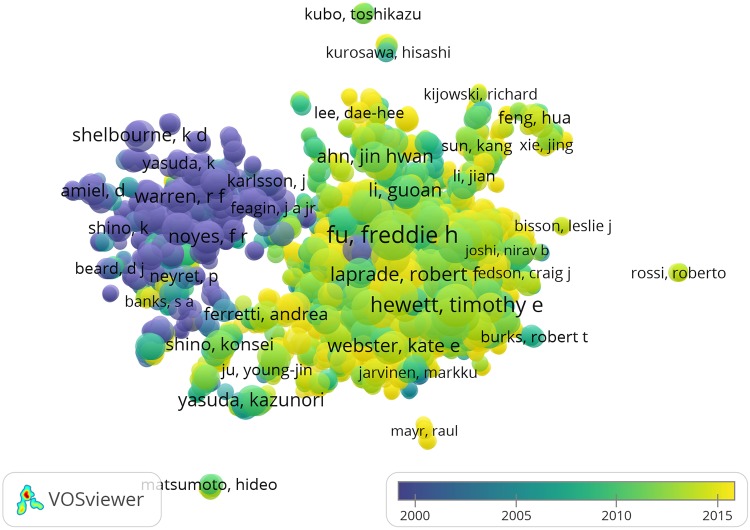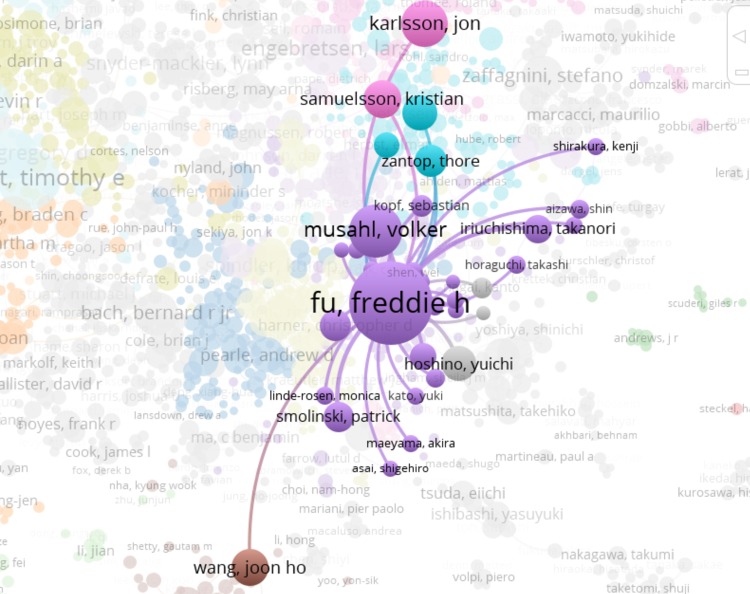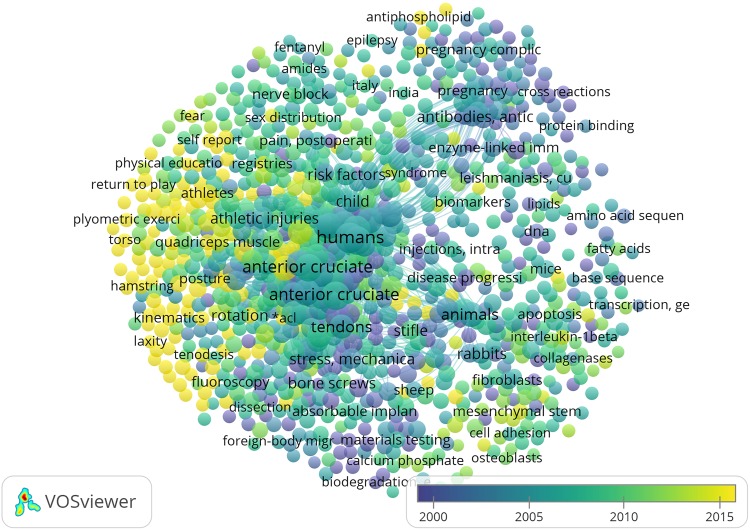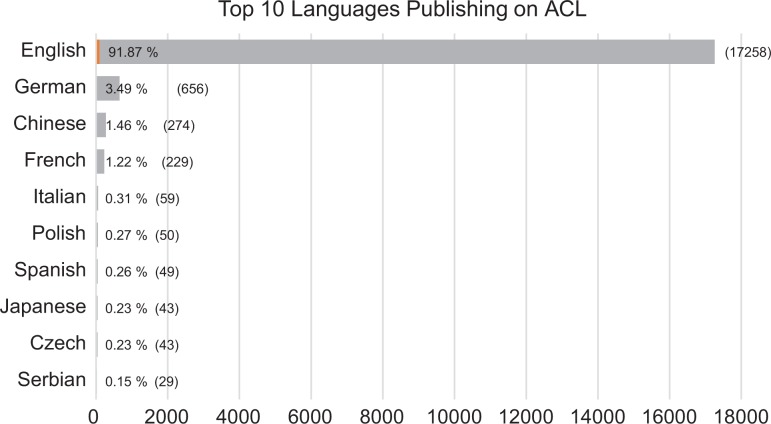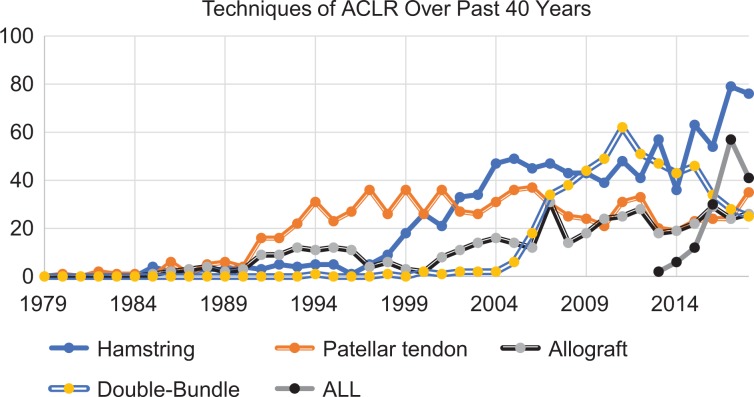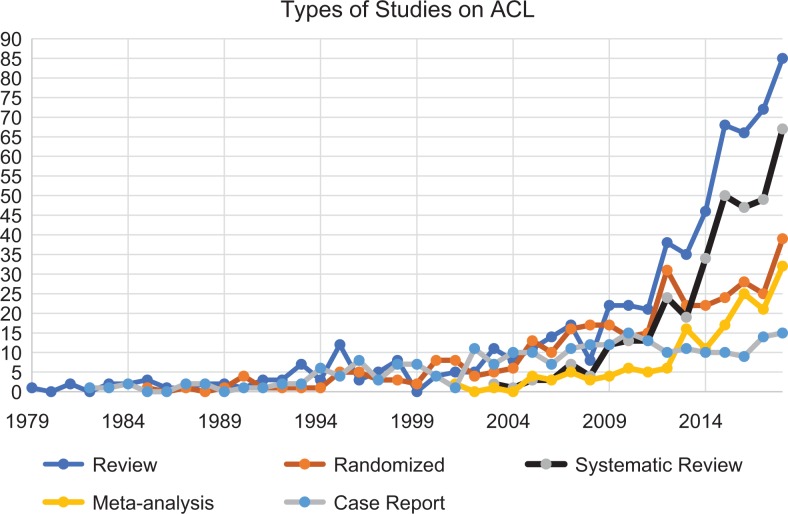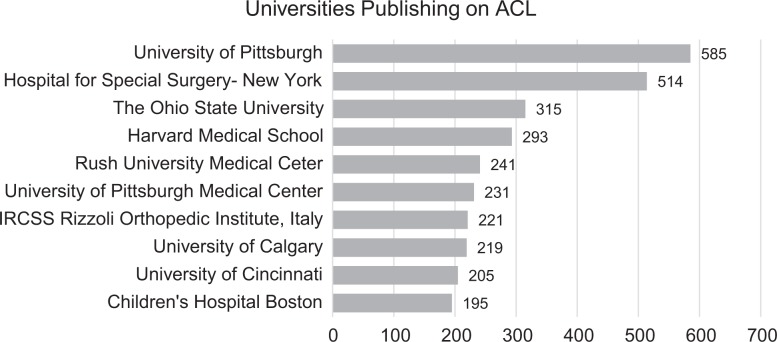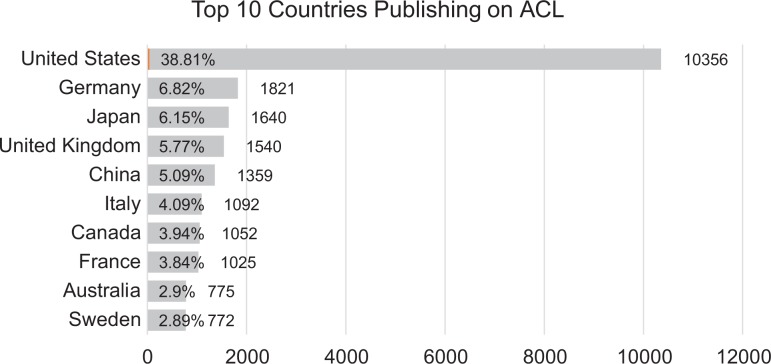Abstract
Background:
The anterior cruciate ligament (ACL) is the most commonly operated ligament of the knee. Details on the top journals, universities, and authors on the topic would be helpful to identify the sources of information for clinical and research queries as well as to observe trends for future research and identify universities/authors of particular interest for training or to follow their research.
Purpose:
To consolidate information from PubMed on the ACL from 1979 to 2018, spanning 40 years.
Study Design:
Cross-sectional study.
Methods:
A search of the PubMed database was conducted for the ACL, and 18,696 articles published over the past 40 years were analyzed for further details. These details included the number of publications per year, top 10 journals publishing on the ACL, top 10 first authors publishing articles on the ACL, and number of articles published with specific keywords. Data were also sought from the Scopus database regarding the top universities and countries publishing on the ACL. The coauthorship of articles and co-occurrence of terms in titles were also analyzed using VOSviewer.
Results:
There was a steady increase in the yearly average number of publications from 1979 to 2018. The top journal and top author publishing on the ACL were The American Journal of Sports Medicine and Freddie H. Fu, respectively. The most articles published by a first author were by K. Donald Shelbourne. Time-based links of Dr Fu to other authors were represented as VOSviewer output. Most occurrences of specific keywords in the title were also studied and listed. The United States was the most published country, and 8 of the top 10 universities that published were from this country.
Conclusion:
There has been a steady increase in the number of articles published in PubMed since 1979. It appears that interest on the topic of the ACL has not decreased or stabilized but rather increased significantly over the past few years. This article quantifies the increased interest and could act as a baseline for future studies to compare.
Keywords: anterior cruciate ligament, ACL, publication, PubMed, database search, data mining, knee
PubMed (www.ncbi.nlm.nih.gov/pubmed) was started in 1996 as an experimental database by the National Center for Biotechnology Information (NCBI) at the National Library of Medicine, US National Institutes of Health, and was officially made free via MEDLINE access by June 1997. Literature searches before this included searches through Index Medicus, which was a quarterly publication. What used to be a quarterly update of literature in Index Medicus has been converted to almost daily updating with the inception of PubMed.
The anterior cruciate ligament (ACL) is the most commonly studied ligament in the knee. Publications on this topic run into the thousands, and yet, there is no study that has looked into the literature from PubMed to provide an overall picture on the trends of publications on this topic. It is often confusing for the beginner to find good sources of information on the ACL. In this study, results on the ACL from PubMed using a search strategy were analyzed to find journal publication details about the topic in the literature. This study aimed to consolidate knowledge in PubMed from 1979 to 2018, spanning 40 years.
Methods
The following search strategy was used: terms used to search in PubMed were “anterior cruciate ligament”[MeSH] OR “anterior cruciate ligament injuries”[MeSH] OR “(ACL AND knee)”. The search resulted in a total of 19,060 articles from 1948 to 2019. Only completed years were included, and hence, articles from 2019 (n = 231) were excluded. This resulted in 18,829 articles. Further, articles before 1979 were excluded, including only those published in the past 40 years. There were only 133 articles published before 1979. This resulted in 18,696 articles. These articles were included for analysis.
All types of studies were included: human and animal studies including experiments, case reports, and meta-analyses. No filters were used, as all types of articles were sought in all languages on this topic.
In comparison with other databases, the search term “anterior cruciate ligament” resulted in a total of 43,100 articles from Semantic Scholar, 13,652 articles from Web of Science, 32,624 articles from EBSCO databases (consisting of CINAHL Plus with Full Text; MEDLINE with Full Text; PsycINFO; Psychology and Behavioral Sciences Collection; Health Business Elite; Biomedical Reference Collection: Comprehensive Edition; Library, Information Science and Technology Abstracts; and eBook Collection [EBSCOhost]), and 26,686 articles from Scopus. The Scopus database was queried to obtain the top 10 countries and universities publishing on this topic as well as the top 10 cited articles on the ACL.
Excel (Office 365 for Mac; Microsoft) was used to create a database, and demographics and data generated from PubMed were loaded and analyzed using this software. VOSviewer11 software (version 1.6.10 8; Leiden University) was used to study coauthorship and the co-occurrence of terms.
Results
Figure 1 shows the yearly distribution of publications. The average number of published articles per year was 467. The average year-by-year increase in the number of publications was 34.72. The study period was also divided into publications before 1996 (before the start of PubMed) and 1996 and after. The yearly average number of published articles was 80.5 before 1996 and 731.8 from 1996 onward, and the yearly incremental increase in publications was 7 before 1996 and 51 from 1996 onward. Thus, there has been a substantial increase in the number of articles published since the inception of PubMed. Since 1979, nine years had negative increment values.
Figure 1.
Number of anterior cruciate ligament (ACL) publications by year.
Of the 18,696 ACL publications in PubMed during the past 40 years, 26 articles were published in 1979, compared with 1380 articles published in the year 2018 alone.
Journals
Figure 2 shows the top 10 journals publishing on the ACL. A total of 1,112 journals have published on the given search terms from 1979 to 2018. Of these, 28 journals belong to veterinary sciences (includes the term “vet” in the journal title), which have published 545 articles on the ACL. Of these veterinary articles, 317 were about cranial cruciate ligament injuries. Studies on animals were included because basic science studies of the ACL are conducted on animals. The American Journal of Sports Medicine was the leading publisher on this topic, with 1960 articles published from 1979 to 2018. The top 5 journals published 34%, while the top 3 journals (The American Journal of Sports Medicine; Knee Surgery, Sports Traumatology, Arthroscopy; and Arthroscopy) published 29% of all articles on the ACL in the study period.
Figure 2.
Top 10 journals publishing on the anterior cruciate ligament (ACL).
Authors
There were a total of 41,936 unique authors, of whom 507 wrote more than 15 publications, 986 wrote more than 10 publications, and 2822 wrote more than 5 publications. Among the first authors as listed on studies, 31 authors wrote ≥20 publications, 61 wrote ≥15 publications, 145 wrote ≥10 articles, and 624 wrote ≥5 articles. Thirty-four articles did not have any authors listed; COR4. Author Freddie H. Fu has published the most number with 378 articles, which is 2% of all articles published on this topic.
Figure 3 shows the top 10 authors with the most publications when listed as the first author, as well as the number of publications when they are listed as one of the authors from 1979 to 2018. Figure 4 shows the top 10 authors reporting on the ACL from 1979 to 2018 (regardless of author order).
Figure 3.
Top 10 first authors with anterior cruciate ligament (ACL) publications. The number at the end of the short bar is the number of articles published when they are listed as the first author. The number within parentheses is the number of articles published by the author when they are listed as one of the authors.
Figure 4.
Top 10 authors with most anterior cruciate ligament publications.
Figure 5 shows output from VOSviewer for all authors. Figure 6 shows an example of links to Dr Fu, author who published the most number of articles on the ACL.
Figure 5.
VOSviewer output for all authors. The more prominent and more significant the author, the bigger the circle; and the more frequent the occurrence of the name, the greater number of publications. Color coding indicates that the publications were more frequent around 2010 and between 2010 and 2015, and color coding of the linked author indicates the predominant year of the link.
Figure 6.
VOSviewer output for Fu FH with links to other authors.
Most Cited/Important Articles
Table 1 lists the titles of the top 10 most cited articles from Scopus for the ACL.
TABLE 1.
Top 10 Most Cited Articles
| Article | No. of Citations |
|---|---|
| Knee Injury and Osteoarthritis Outcome Score (KOOS): Development of a Self-administered Outcome Measure9 | 1486 |
| Biomechanical Measures of Neuromuscular Control and Valgus Loading of the Knee Predict Anterior Cruciate Ligament Injury Risk in Female Athletes: A Prospective Study4 | 1373 |
| Two- to 9-Year Outcome After Autologous Chondrocyte Transplantation of the Knee8 | 1098 |
| The Long-term Consequence of Anterior Cruciate Ligament and Meniscus Injuries: Osteoarthritis6 | 1070 |
| The Cruciate Ligaments of the Knee Joint: Anatomical, Functional and Experimental Analysis3 | 1050 |
| Knee Injury Patterns Among Men and Women in Collegiate Basketball and Soccer: NCAA Data and Review of Literature1 | 1047 |
| Biomechanical Analysis of Human Ligament Grafts Used in Knee-Ligament Repairs and Reconstructions7 | 1012 |
| Epidemiology of Collegiate Injuries for 15 Sports: Summary and Recommendations for Injury Prevention Initiatives5 | 959 |
| Fate of the ACL-Injured Patient: A Prospective Outcome Study2 | 881 |
| Accelerated Rehabilitation After Anterior Cruciate Ligament Reconstruction10 | 847 |
Keywords
Figure 7 shows the frequently occurring keywords related to the ACL from 2000 to 2015. While terms including animals and enzyme fatty acids related to basic sciences appear prominent toward 2000, terms such as “plyometrics,” “physical education,” “kinematics,” “fluoroscopy,” “registries,” and “return to play” figure more prominently toward 2015.
Figure 7.
Most frequently occurring keywords related to the anterior cruciate ligament (ACL) in PubMed.
A clinically relevant keyword search was conducted from the titles of all articles on the ACL, and the results are presented in Table 2. The terms included types of grafts used, complications, types of procedures (eg, double-bundle reconstruction/repair of ACL), and types of studies performed.
TABLE 2.
Keywords From Titles of Articlesa
| Keyword | n (%) | Keyword | n (%) |
|---|---|---|---|
| Reconstruction | 6595 (35.27) | Pivot shift | 81 (0.43) |
| Arthroscop(y/ic) | 1191 (6.37) | Ganglion | 69 (0.37) |
| Hamstrings | 955 (5.11) | Posterolateral corner/PLC | 68 (0.36) |
| Patellar tendon | 788 (4.21) | Double bundle | 64 (0.34) |
| Review (all types) | 618 (3.31) | PCL | 62 (0.33) |
| Repair | 578 (3.09) | Infection | 61 (0.33) |
| Athlet(e/ic/ics) | 548 (2.93) | Randomised | 50 (0.27) |
| Kinematic | 499 (2.67) | Congenital & absen(t/ce) | 49 (0.26) |
| Allograft | 447 (2.39) | Return to play | 42 (0.22) |
| Quadriceps | 386 (2.06) | Cyclops | 41 (0.22) |
| Randomized studies (includes prospective + RCTs) | 353 (1.89) | Multiligament/multi-ligament | 41 (0.22) |
| Systematic review | 348 (1.86) | Mucoid degeneration | 36 (0.19) |
| Revision | 290 (1.55) | Segond | 42 (0.22) |
| Interference | 289 (1.55) | Registry/registries (32/8) | 40 (0.21) |
| Case report | 241 (1.29) | Case series | 29 (0.16) |
| Risk factor | 185 (0.99) | Accelerated | 22 (0.12) |
| Complication | 163 (0.87) | Notchplasty | 21 (0.11) |
| Meta-analysis | 161 (0.86) | BPTB | 20 (0.11) |
| Anterolateral ligament | 148 (0.79) | PRP/platelet rich plasma | 18 (0.10) |
| Dislocation | 139 (0.74) | BTB | 10 (0.05) |
| RCT/(randomised/randomized) controlled trial | 122 (0.65) | Plyometric | 7 (0.04) |
| Paediatric/pediatric | 104 (0.56) | Day case | 5 (0.03) |
aBPTB, bone–patellar tendon–bone; BTB, bone–patellar tendon–bone; PCL, posterior cruciate ligament; PLC, posterolateral corner; PRP, platelet-rich plasma; RCT, randomized controlled trial.
Language
Figure 8 shows the top 10 languages of publications in PubMed. English was the predominant language, followed by German, Chinese, French, and Italian. The total number of articles for this group was 18,784 on PubMed from 1979 to 2018.
Figure 8.
Top 10 languages for anterior cruciate ligament (ACL) publications.
Timeline Trends of ACL Techniques and Types of Studies
Figure 9 shows the type of grafts used for ACL reconstruction found by analyzing article titles. While the patellar tendon was more popular in the early 1990s, the hamstring tendon appeared more frequently starting in the late 1990s and steadily increased, with more than 75 articles from 2017 to 2018. The patellar tendon plateaued at between 20 and 40 articles in the 1990s. Double-bundle reconstruction had an interesting timeline, with a rapid increase in publications from 2005 to a peak of 60 per year in 2011; that trend has been decreasing, with only 25 publications in 2018. The anterolateral ligament started appearing in 2013 with 2 publications, increasing to 57 in 2017 and 41 in 2018. Allografts have seen a slow and steady increase, starting at 1 article in 1985 to 11 in 1996; it witnessed a dip from 1997 to 2001. The trend from then has been steadily increasing, ending with 26 publications in 2018.
Figure 9.
Graft types used in anterior cruciate ligament reconstruction (ACLR) over the past 40 years, based on analysis of article titles. ALL, anterolateral ligament.
Figure 10 shows the types of publications on the ACL found by analyzing article titles. Reviews have been present from 1979 and demonstrated an increasing trend, ending with 85 in 2018. Studies of high quality (with higher levels of evidence), including systematic reviews, meta-analyses, and randomized studies, showed an increasing trend in the past 5 years. Randomized controlled trials started appearing in the literature starting in 1985 and ending with 39 studies published in 2018. However, meta-analyses and systematic reviews first appeared in the literature in 2002 and 2001, respectively, and have shown an increasing trend since. Case reports have plateaued at 10 to 15 a year since 2001.
Figure 10.
Types of studies on the anterior cruciate ligament (ACL) over the past 40 years, based on analysis of article titles.
Discussion
PubMed is an excellent resource for information on research undertaken in the past in medicine, and with the advent of data mining tools, current and future research trends can be mined from the available data. Until 2014, PubMed used to be updated 5 times a week. However, since June 2014, updating is being done daily. It is freely available to all. It has helped speed up literature searches and publications from a few weeks/months to a few days in some cases. The problem of literature searches also has been simplified, as such searches were previously conducted in the library of an institution that had access to Index Medicus for all years; thus, there were limitations on space and time for conducting literature searches . Currently, searches can be conducted on PubMed and other databases even outside working hours, in the comfort of our homes, in a few seconds with an internet connection. There have also been technological advances in the process of submitting articles to journals and reviewing, editing, and publishing that have sped up the publication process multifold; hence the proliferation of the number of journals to take the increased load of reporting.
The number of publications on the ACL has been increasing, especially since PubMed was introduced. This number was about 26 in 1979, increasing to more than 500 per year by 2005 and crossing 1000 per year by 2015. It took almost 60 years from 1948 to cross 500 per year but only 10 years (2005-2015) to increase from 500 to 1000 publications per year. In the past 10 years alone (2009-2018), 10,070 articles were published, constituting 54% of the total number of articles published on the topic.
Although there were publications before 1979, these were not included in this study, as in most of the years, the number of publications was less than 10 per year, and there were some years without any publications (the average from 1948 to 1978 was 5.54 per year). The first publication on the ACL was in 1948.
It has to be kept in mind that authors who published before 1998 were doing so without online PubMed in its current form. Authors who started publishing after 2000 and in recent years have had several computer and software tools available to speed up the process of writing, publishing, and accurate reporting; these include better statistical methodologies as well as better and faster submission, reviewing, and editing processes by journals. Hence, the numbers given in Figures 3 and 4 do not compare equally between the authors with regard to the amount of work done by authors across the period or from different generations.
When PubMed was queried from January 1, 1979, to December 31, 2018, it resulted in a total of 18,784 articles, whereas our database (taken from PubMed) offered 18,696 articles for the same period. There is a discrepancy in the results from different databases taken from PubMed itself: one from the user interface and the other downloaded from PubMed directly.
Current results from PubMed searches lack details such as the country of origin/institution. These data need to be extracted indirectly. The quality of our results is dependent on the quality of the data obtained from PubMed. Improvements in PubMed and how data on articles are stored in it will improve results in the future. More details about data may be mined if storing is standardized. One hurdle for this is that authors, reviewers, and publishers need to be aware of these standards to be able to store and retrieve data of good quality. Currently, the results from PubMed lack consistency and tend to offer different numbers for the same query from different sources within it. However, the trends would not be affected if the results are in large numbers.
As this article provides a summary of publications, we felt it prudent to include the top 10 most cited articles on this topic, although from the Scopus database these are (see Table 1). Figures 11 and 12 show the top 10 universities and countries publishing on the ACL, respectively. These data were also obtained from Scopus, with a total of 26,153 articles on February 28, 2019 (1979-2018). Although the numbers vary between Scopus and PubMed, the trends appear similar in other searches between the 2 databases. Among the universities, 8 of the top 10 were located in the United States. One university was in Italy and 1 in Canada. Among the countries publishing most on the ACL, the United States published about 38.8% of all articles on the ACL, followed by Germany (6.8%). Interest in double-bundle reconstruction seems to be decreasing, whereas the number of publications on hamstring ACL reconstruction and the anterolateral ligament has been increasing in recent years.
Figure 11.
Top 10 universities publishing on the anterior cruciate ligament (ACL).
Figure 12.
Top 10 countries publishing on the anterior cruciate ligament (ACL).
Limitations of the analysis used here are that when dealing with data running into thousands, the results may not be consistent and hence need not be accurate to the last digit but will be close to the correct value. However, trends would be similar across most databases. Whenever results were felt to be inconsistent, a search was run a minimum of 3 times until a consistent number was obtained. Results of mining data depend on how the data are entered in the database. If spellings of terms vary between countries, entries may not show up on searches with 1 term only. For example, “randomized” and “randomised” are 2 different terms used for studies by different journals/authors. To be able to obtain consistent results, data entry should be made uniform across all journals.
Conclusion
There have been a large number of articles on the topic of the ACL published since 1979. Mining the data on the ACL in PubMed produced useful information about good sources of publications on this topic, including authors/journals that could be followed. The strength of their association with other authors could potentially indicate coworkers, common research interests, and collaborative studies. The increasing number of publications in recent years indicates continually increased interest on this topic.
Footnotes
The authors declared that there are no conflicts of interest in the authorship and publication of this contribution. AOSSM checks author disclosures against the Open Payments Database (OPD). AOSSM has not conducted an independent investigation on the OPD and disclaims any liability or responsibility relating thereto.
Ethical approval was not sought for the present study.
References
- 1. Arendt E, Dick R. Knee injury patterns among men and women in collegiate basketball and soccer: NCAA data and review of literature. Am J Sports Med. 1995;23(6):694–701. [DOI] [PubMed] [Google Scholar]
- 2. Daniel DM, Stone ML, Dobson BE, Fithian DC, Rossman DJ, Kaufman KR. Fate of the ACL-injured patient: a prospective outcome study. Am J Sports Med. 1994;22(5):632–644. [DOI] [PubMed] [Google Scholar]
- 3. Girgis FG, Marshall JL, Monajem A. The cruciate ligaments of the knee joint: anatomical, functional and experimental analysis. Clin Orthop Relat Res. 1975;106:216–231. [DOI] [PubMed] [Google Scholar]
- 4. Hewett TE, Myer GD, Ford KR, et al. Biomechanical measures of neuromuscular control and valgus loading of the knee predict anterior cruciate ligament injury risk in female athletes: a prospective study. Am J Sports Med. 2005;33(4):492–501. [DOI] [PubMed] [Google Scholar]
- 5. Hootman JM, Dick R, Agel J. Epidemiology of collegiate injuries for 15 sports: summary and recommendations for injury prevention initiatives. J Athl Train. 2007;42(2):311–319. [PMC free article] [PubMed] [Google Scholar]
- 6. Lohmander LS, Englund PM, Dahl LL, Roos EM. The long-term consequence of anterior cruciate ligament and meniscus injuries: osteoarthritis. Am J Sports Med. 2007;35(10):1756–1769. [DOI] [PubMed] [Google Scholar]
- 7. Noyes FR, Butler DL, Grood ES, Zernicke RF, Hefzy MS. Biomechanical analysis of human ligament grafts used in knee-ligament repairs and reconstructions. J Bone Joint Surg Am. 1984;66(3):344–352. [PubMed] [Google Scholar]
- 8. Peterson L, Minas T, Brittberg M, Nilsson A, Sjögren-Jansson E, Lindahl A. Two- to 9-year outcome after autologous chondrocyte transplantation of the knee. Clin Orthop Relat Res. 2000;374:212–234. [DOI] [PubMed] [Google Scholar]
- 9. Roos EM, Roos HP, Lohmander LS, Ekdahl C, Beynnon BD. Knee Injury and Osteoarthritis Outcome Score (KOOS): development of a self-administered outcome measure. J Orthop Sports Phys Ther. 1998;28(2):88–96. [DOI] [PubMed] [Google Scholar]
- 10. Shelbourne KD, Nitz P. Accelerated rehabilitation after anterior cruciate ligament reconstruction. Am J Sports Med. 1990;18(3):292–299. [DOI] [PubMed] [Google Scholar]
- 11. VanEck NJ, Waltman L. VOSviewer version 1.6.10. http://www.vosviewer.com/. Accessed February 20, 2019.



